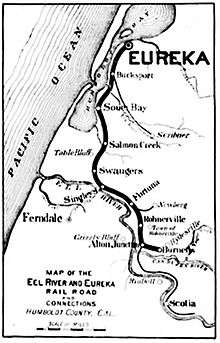Eel River and Eureka Railroad
| Locale | California's North Coast from Eureka - Alton, California |
|---|---|
| Dates of operation | 1882–1902 |
| Successor | San Francisco and Northwestern Railway |
| Track gauge | 4 ft 8 1⁄2 in (1,435 mm) standard gauge |
| Previous gauge |
|
| Headquarters | Eureka |

The Eel River and Eureka Railroad company was organized on November 14, 1882 by a group of Eureka businessmen led by John M. Vance (b. Nova Scotia October 1, 1821 - d. January 1892).[1] One of the other founders of the line was William Carson.[2]
History
The primary 25 miles (40 km) of the Eel River and Eureka Railroad ran from the line's office and depot at the foot of Second Street, Eureka to Burnell's station, a town near Hydesville.[3] The longest tunnel was nearly 2,000 feet (610 m) through Table Bluff[3] between the stops of Salmon Creek and Swauger's Station.
By 1896, the Eel River and Eureka Railroad was running passenger trains twice a day, every day but Sunday when there were three trains.[4] From June 1895 to June 1896, the line had 32,811 passengers who paid a total of $24,748.70 in fares.[4] In the same period, the line earned $67,568.85 from lumber and freight, over 3,000 tons of which was butter from the Eel River Valley dairies.[4]
After the junction at Alton the Pacific Lumber Company Railroad extended south about 4 miles (6.4 km) through and slightly beyond the town of Scotia.[3]
In October 1902, all the property and rights of the Eel River and Eureka Railroad were transferred to the San Francisco and Northwestern Railway.[5]
The tracks became part of a continuous line from San Francisco to Trinidad in the summer of 1914.[6] On December 28, 1918, the San Francisco and Northwestern Railway transferred the assets to the Northwestern Pacific Railroad.[5]
References
- ↑ California Public Utilities Commission (1892). "Eel River and Eureka RailRoad Company". Annual Report Public Utilities Commission: 275+. OCLC 7954748. Retrieved 15 September 2011.
- ↑ Lynwood Carranco; John T. Labbe (1 January 1975). Logging the Redwoods. Caxton Press. pp. 112–. ISBN 978-0-87004-536-3.
- 1 2 3 Hamm, Lillie E. Hamm (1890). Railroad Enterprises of Humboldt County: History And Business Directory Of Humboldt County. Eureka, California: Daily Humboldt Standard. p. 224. OCLC 11879512. horizontal tab character in
|id=at position 6 (help) - 1 2 3 Vaughn, Melville M. (September 1896). "A California Principality: Humboldt and its Redwoods". The Overland Monthly 28 ((Second Series) 165): 320–368. OCLC 168623387. Retrieved 15 September 2011.
- 1 2 Supreme Court of California, 3 August 1921 (1921). "Northwestern Pacific R. Co. versus Humboldt Milling Co. (S.F. 9113.)". Pacific Reporter (St. Paul, Minnesota: West Publishing Company) 200: 1184 pages. OCLC 1761690. horizontal tab character in
|id=at position 6 (help) - ↑ Sims, Hank (May 29, 2003). "Going Nowhere: Has the Northwestern Pacific Railroad reached the end of the line?". North Coast Journal. Retrieved 15 September 2011.